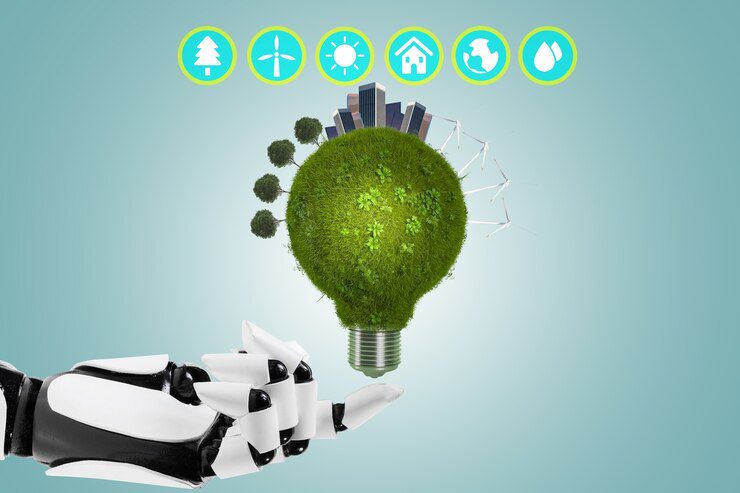The Earth is warming, and the urgency of action has never been greater. While the challenges seem insurmountable, a glimmer of hope shines through the cracks: Artificial Intelligence (AI). This powerful technology, previously relegated to science fiction, is now emerging as a potential game-changer in the fight against climate change. But how exactly can AI for climate change tackle this global crisis?
Prediction and Prevention
One of AI’s greatest strengths lies in its ability to analyze vast amounts of data and identify patterns. This makes it ideal for predicting extreme weather events, natural disasters, and even future climate trends. By anticipating these events, we can better prepare for their impact, minimizing damage and saving lives. AI-powered early warning systems can alert communities to impending floods, droughts, or wildfires, allowing for proactive measures like evacuation or resource allocation.
Optimizing Energy Consumption and Production
Energy production is a key contributor to global greenhouse gas emissions. However, AI can help us transition to a cleaner future by optimizing energy consumption and production. Smart grids powered by AI for climate change can predict energy demand and adjust supply accordingly, minimizing waste and integrating renewable sources like solar and wind power more effectively. Additionally, AI-driven maintenance systems can predict equipment failures in power plants, preventing disruptions and ensuring efficient operation.
Revolutionizing Agriculture and Transportation
Agriculture accounts for a significant portion of global emissions. AI can help farmers optimize their practices, reducing their environmental footprint. By analyzing soil data and weather patterns, AI can recommend optimal planting times, water usage, and fertilizer application, minimizing waste and maximizing yields. In transportation, AI-powered logistics systems can optimize delivery routes, reducing fuel consumption and emissions. Additionally, self-driving cars, while still in their infancy, hold the potential to revolutionize transportation, potentially leading to fewer vehicles on the road and lower emissions.
Carbon Capture and Storage
Directly capturing and storing atmospheric carbon is another crucial aspect of climate change mitigation. AI can play a vital role in identifying optimal locations for carbon storage, designing efficient capture technologies, and even predicting the potential environmental impact of such projects. This can help us accelerate the development and deployment of these technologies, contributing to a cleaner atmosphere and sustainable practices.
Challenges and Ethical Considerations
While AI for climate change holds immense promise, it’s important to acknowledge the challenges and ethical considerations involved.
Data Bias: AI algorithms are only as good as the data they’re trained on. Biased data can lead to discriminatory or harmful outcomes. Ensuring diverse and ethical data sets is crucial to avoid perpetuating inequalities.
Job Displacement: Automation through AI for climate change could lead to job losses in certain sectors. It’s essential to invest in reskilling and upskilling programs to ensure a smooth transition.
Accessibility and Equity: Access to AI technology and its benefits needs to be equitable. Investing in infrastructure and training programs across developing and developed nations is crucial.
Empowering Climate Advocacy and Policy-Making
Effective climate action requires informed decision-making and widespread public engagement. AI-driven analytics empower policymakers with actionable insights into environmental monitoring, socioeconomic impacts, and policy effectiveness. Natural language processing algorithms analyze vast repositories of scientific literature, policy documents, and public discourse to identify emerging trends, assess stakeholder perspectives, and inform evidence-based policymaking. Furthermore, AI-powered communication tools facilitate public awareness campaigns, stakeholder consultations, and community engagement initiatives, fostering a collective commitment to climate action.
Conclusion
AI for climate change is not a silver bullet, but it is a powerful tool in our arsenal against climate shift. By leveraging its capabilities for prediction, optimization, and innovation, we can accelerate the transition to a more sustainable future. However, responsible development and deployment are crucial to ensure that AI benefits all of humanity and the planet we share. In the face of escalating climate change challenges, artificial intelligence emerges as a powerful ally in the quest for sustainable development and environmental stewardship. From climate modeling and energy optimization to conservation efforts and disaster response, AI-driven solutions offer innovative pathways to mitigate the impacts of climate change and build a resilient future. By harnessing the transformative potential of AI, we can forge a path towards a more sustainable and equitable world for present and future generations.







